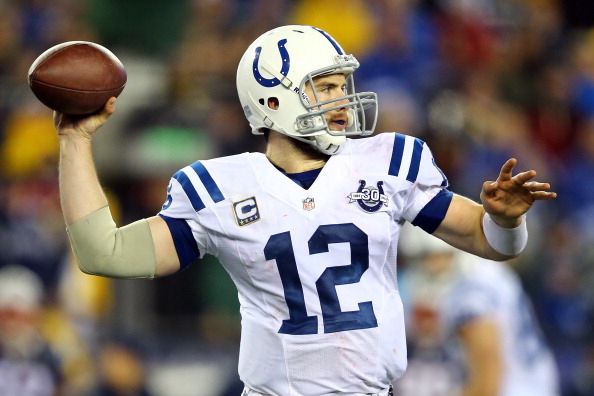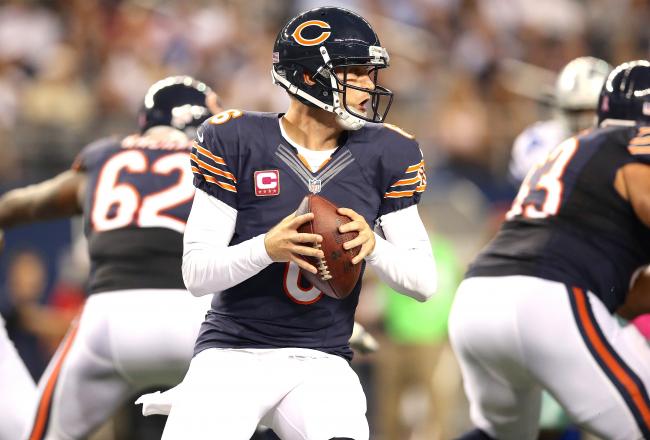It’s not a matter of if, but when Indianapolis Colts quarterback Andrew Luck gets a long-term contract from his current team. Luck, the No. 1 overall pick of the 2012 NFL Draft, is currently working off of his fifth-year option, worth $16.155 million for 2016 and is set to be an unrestricted free agent at the end of the season.
The Colts don’t seem interested in waiting that long for a deal to get done, however, with owner Jim Irsay saying in March that July 4 is the target date to get a contract inked. (Though that’s since been amended to be any time before training camp begins in late July.)
What hasn’t changed, though, is Irsay’s desire to lock Luck down to a “shocking,” multi-year deal, one that according to a source close to Bleacher Report’s Jason Cole could very well make Luck the highest-paid player in the league. This isn’t just bluster on Irsay’s behalf—it’s very likely to happen, probably earning Luck somewhere around $25 million in average per-year value. And it’s also not shocking, given the contracts we’ve seen handed out in recent years and the way teams treat the quarterback position, in particular.
It both matters and doesn’t matter, therefore, what kind of deal the Colts give to Luck. Because of this, what will go down later this summer between the quarterback and his franchise will have a ripple effect on the NFL as a whole.
We all know that the quarterback position carries more weight than any other, whether rightly (he is the on-field offensive general, after all) or wrongly (using quarterback wins as a meaningful stat). Teams will bet anything but a literal farm to acquire one who may even slightly resemble a long-term solution at the position.

That’s why Washington traded so many picks in 2012 for the No. 2 spot in the draft to select Robert Griffin III. It’s why the Los Angeles Rams moved up to No. 1 this year for Jared Goff and the Philadelphia Eagles moved up to No. 2 for Carson Wentz. And it’s why the Colts didn’t take the entire Browns’ 2012 cadre of draft picks to lose Luck to another team.
Thus, once the “finding one” aspect of locating a long-term solution at the position is over, the “keeping him” aspect takes control. Luck would have had to have been a bust of JaMarcus Russell proportions for the Colts to even begin entertaining life without him in 2017. It’s simply not going to happen. And while Luck has his flaws—his completion percentage of 58.1 percent could use improvement and the organization as a whole has done an almost laughable job of providing him help via receivers, offensive line and the run game—there’s no chance the Colts will do better than him, whether in the next year’s draft or in free agency.
Yet that also means the Colts will be tethering themselves to Luck for the long term and hope this was ultimately the right move. Luck should have played better than he has over the last four years, but nothing guarantees that he will. (Though the luxury of having time to continually get better will likely pay dividends.) Like any contract offered in the NFL, the goal is to prognosticate and pre-reward future performance, not past accomplishments. Clearly, a record-breaking contract would indicate the Colts’ confidence in Luck going forward.
But it doesn’t just matter to Luck and the Colts what kind of contract the two settle on later this summer—it also matters to other quarterbacks who will be pursuing new deals in the coming years. Luck is on the verge of setting the high bar at the position, which means agents for Goff, Wentz, Marcus Mariota and Jameis Winston—all recent Nos. 1 and 2 draft picks—as well as 2017 and 2018 free agents like Kirk Cousins, Tyrod Taylor and Matt Stafford will be watching closely the total value, structure and guaranteed money in Luck’s next deal.
In a general sense, precedent, more than anything, dictates position-by-position market value; only when it comes down to the specific contract value is the specific player’s worth and potential considered.
But Luck’s impending status as the NFL’s “highest paid player” also doesn’t matter. While the millions of dollars in actual paychecks he will receive certainly are tangible dollars, the deal as a whole entity is as abstract as the concept of being the “highest paid” anything in a league that does not have fully guaranteed contracts. Take, for example, the current highest-value contract (in total money) right now: The seven-year, $126.7 million deal inked between the Chicago Bears and quarterback Jay Cutler in 2013, a deal that runs through the 2020 season.
Though the potential exists that Cutler could earn every penny of that $126.7 million, the reality is that he more than likely won’t. Indeed, the vast majority of (non-rookie, high-round) contracts don’t reach maximum value and full length, especially not those which seem the most expensive. Indeed, if Cutler is released after 2016 (something not unrealistic, as it will only cost the Bears $2 million to do so and $16 million to keep him in 2017 alone), he will have earned $71.97 million of the contract’s full value.
An even better example is Colin Kaepernick. In total value, his six-year, $114 million is the third-highest in the league. Yet just under $13 million of that is guaranteed up front, or just 11.4 percent of the deal’s total cash. To earn more than that, he must hit certain trigger dates (April 1 for 2015, 2016, 2017 and 2018) and meet specific playing time and performance-based escalators. If released following the 2016 campaign, Kaepernick will be earning around $35 million of the $114 million contract total.
As you can see, it’s not the total value or length of Luck’s deal that matters. That’s simply optics, an opportunity for bragging rights. But the way the contract is structured—including fully guaranteed money, the percentage that is guaranteed and other fine-print details—is what will truly determine the historical impact of Luck’s “highest-paid all-time” claims.
https://twitter.com/NFLonLive/status/661395892566695936
Another factor to consider is the salary cap. “Big-money” deals aren’t the same big-money deals they used to be, thanks to the precipitously rising cap space each team has every spring. In 2013, teams had at least $123.6 million to spend (“at least,” because teams can preserve cap space from previous years and carry it over to each subsequent one). In 2014, that number rose to $133 million. It was $143.2 million in 2015 and a whopping $155.27 million in 2016.
Should the cap keep rising at this pace, teams are finding themselves with dozens of millions more dollars to spend on their players. And while cash-hoarding is not unheard of (11 teams right now have $15 million or more in excess space), teams do have to spend 89 percent of their total cap room over three-year periods (one just ended-slash-began this league year) to encourage a proper balance between saving and spending.
Thus, what teams would never consider doing, contract-wise, just three seasons ago now seem like routine, painless extensions and new deals are being offered without blinking. An $80 million deal in 2013 can now be a $100 million deal, a $13 million cap hit can now be $19 million and the team can remain financially comfortable. Bank-breaking is hard to do when the bank keeps being replenished with ever-increasing amounts of money every year.
So while Luck’s inevitable new deal will seem like a massive amount of money, that’s not what really matters. What matters is how that impacts the Colts on the field for however long they are truly planning on having him under center. It matters to other highly-prized or talented quarterbacks who will be seeking new contracts in the coming years. It matters based on structure and guarantees, only. But when the nature of NFL contracts are to be purposefully not what they seem and the salary cap keeps being bumped up so significantly every year, Luck’s perceived big payday will become more and more commonplace around the league.








